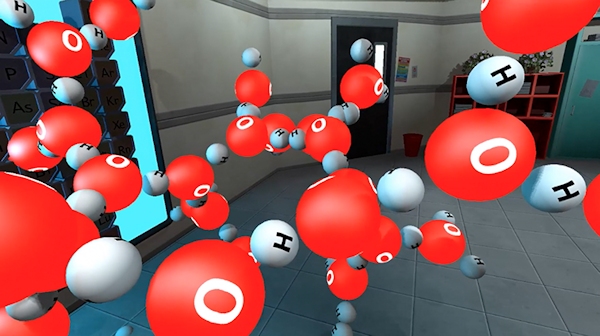[From Fast Company, where the story includes a photo gallery and the referenced 2:20 minute video]
Interactive Virtual Reality In 3-D, The Newest Learning Tool
Watch what happens when the Oculus Rift headset and the Leap Motion 3-D gesture controller are combined to help kids learn the periodic table.
By Ariel Schwartz
February 27, 2014
Remember the days when students would come to class armed with only a notebook and a textbook? In some places, that time is long gone, as laptops and iPads make their way into schools. Now a creative technology studio has come up with a platform for classrooms that makes digital textbooks look ancient.
Chaotic Moon’s immersive 3-D experience allows students to manipulate virtual objects and experience whatever they’re studying firsthand. The platform marries a Leap Motion gesture controller with an Oculus Rift virtual reality headset so that students can experience scenarios arguably more memorable than anything they’d read in a book. In [the video demo], a “student” learns about atoms and molecules by looking at the periodic table of elements in 3-D, manipulating hydrogen and oxygen atoms, and finally taking a trip under the sea to hammer home the importance of H2O.
The idea started as a passion project for Chaotic Moon CEO Ben Lamm, who previously had started an education technology company. He knew people at Leap Motion and happened to have an Oculus Rift sitting around for client work. “We learned over the years that people retain 10% of what they read, 50% of what they hear, and 90% of what they do,” Lamm says. “We wanted to build something that’s not e-learning, but more like i-learning–immersive learning.”
After consulting with an education company, Chaotic Moon put together the periodic table demo. While it focuses on chemistry, the platform could be used for any number of educational topics. Students could, say, interact with the flora and fauna of the Amazonian jungle–or even its inhabitants–or perhaps travel inside a virtual circulatory system. “We can’t miniaturize people yet. That’s our next project,” Lamm jokes. Outside of education, the platform could be useful in other sectors such as gaming or oil and gas extraction.
Chaotic Moon is already working on another demo involving an underwater shark attack game. According to Lamm, the experience is realistic enough that it’s a little scary at times. “The resolution on the [Oculus Rift] demo kits is a little pixelated, but even with that, your brain looks past all that,” he says. “When you put it on and you see a shark come by, it kind of freaks you out.”
